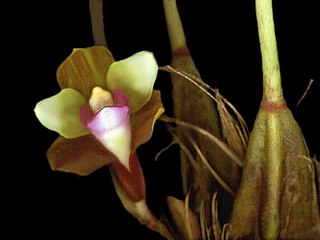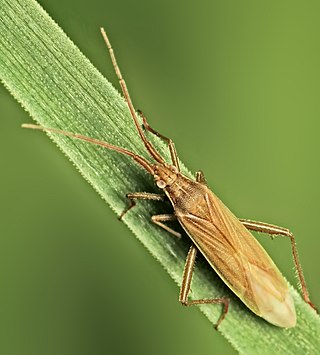
Troschel's treefrog, also known as the blue-flanked treefrog or the convict treefrog, is a species of frog in the family Hylidae. It is found in most parts of the Amazon Basin, except in the southeast and the Guianas. Colombian, Venezuelan, and Surinamese records need confirmation.

The Colombian horned frog or Venezuelan horned frog is a species of frog in the family Ceratophryidae. It is found in Colombia and Venezuela. Its natural habitats are dry savanna, subtropical or tropical dry shrubland, subtropical or tropical dry lowland grassland, and intermittent freshwater marshes.
Scaphiophryne calcarata, Moquard's Burrowing Frog, is a species of frog in the family Microhylidae. It is endemic to Madagascar. Its natural habitats are subtropical or tropical dry forests, dry savanna, moist savanna, subtropical or tropical dry shrubland, subtropical or tropical dry lowland grassland, intermittent freshwater marshes, arable land, and urban areas. The species is adaptable and is not affected by deforestation.
Rollinia calcarata is a species of plant in the Annonaceae family. It is endemic to Brazil.

Bifrenaria calcarata is a species of orchid.

Eltroplectris, the long-claw orchid, is a genus of flowering plants from the orchid family, Orchidaceae. It is native to South America, the West Indies, and Florida.
- Eltroplectris assumpcaoanaCampacci & Kautsky - Brazil
- Eltroplectris brachycentronSzlach. -Bolivia
- Eltroplectris calcarata(Sw.) Garay & H.R.Sweet - Florida, Bahamas, Cayman Islands, Cuba, Hispaniola, Jamaica, Puerto Rico, Windward Islands, Trinidad, Suriname, Venezuela, Colombia, Peru, Brazil, Paraguay
- Eltroplectris cogniauxiana(Schltr.) Pabst - Brazil
- Eltroplectris dalessandroiDodson - Ecuador
- Eltroplectris janeirensis(Porto & Brade) Pabst - Brazil
- Eltroplectris kuhlmanniana(Hoehne) Szlach. & Rutk. in P.Rutkowski, D.L.Szlachetko & M.Górniak - Brazil
- Eltroplectris longicornu(Cogn.) Pabst - Brazil
- Eltroplectris macrophylla(Schltr.) Pabst - Brazil
- Eltroplectris misera(Kraenzl.) Szlach. - Brazil
- Eltroplectris rossiiDodson & G.A.Romero - Ecuador
- Eltroplectris schlechteriana(Porto & Brade) Pabst - Brazil, Argentina, Paraguay
- Eltroplectris triloba(Lindl.) Pabst - Brazil, Argentina, Paraguay

Sveltia is a genus in the subfamily Cancellariinae of the nutmeg sea snails with an extensive fossil range.

Stenodema calcarata is a species of bug from Miridae family, that can be found in Europe and across the Palearctic to Central Asia, the Russian Far East, Siberia, northern China, Korea and Japan.

Kentropyx calcarata, commonly known as the striped forest whiptail, is a species of lizard endemic to South America.

Eurycantha calcarata is a species of phasmid endemic to Australasia.

Sclerolaena is a genus of annuals or short-lived perennials in the family Chenopodiaceae, which are included in Amaranthaceae according to the APG classification.

Eltroplectris calcarata, the longclaw orchid, is a terrestrial species of orchid. It is native to Florida, Bahamas, Cayman Islands, Cuba, Hispaniola, Jamaica, Puerto Rico, Windward Islands, Trinidad, Suriname, Venezuela, Colombia, Peru, Brazil, and Paraguay.

Artelida is a genus of beetles in the family Cerambycidae, containing the following species:
Oeceoclades calcarata is a terrestrial orchid species in the genus Oeceoclades that is endemic to Madagascar. It was first described by the British botanist Robert Allen Rolfe in 1905 as Eulophia paniculata. The German botanist Rudolf Schlechter later described this species as Cymbidium calcaratum in 1915 and then transferred his own taxon to the genus Eulophia in 1925. When Leslie Andrew Garay and Peter Taylor revised the genus Oeceoclades in 1976, they transferred this species to the expanded Oeceoclades as O. calcarata because even though Eulophia paniculata was the older name and thus had priority, there had already been an earlier species named Oeceoclades paniculata that prevented using that specific epithet.
Centrochelys atlantica is an extinct species of tortoise that lived in the Pleistocene. It was first recorded in the volcanic crater on Sal, Cape Verde. It was initially identified as similar to the extant Testudo calcarata. The species is no longer present anywhere in the Cape Verde islands. It has since been described as a new species, differentiated from C. sulcata by its smaller size and lesser robusticity. It does not seem there is any evidence this species came into contact with humans. Kehlmaier et al. (2021) identified the type material of this species as belonging to a specimen of the red-footed tortoise, making C. atlantica a junior synonym of the latter species and leaving the extinct tortoise known from fossils excavated on the Sal Island in the 1930s without a scientific name.

Saperda calcarata, the poplar borer, is a species of beetle in the family Cerambycidae. It was described by Thomas Say in 1824. It is known from Canada and the United States. It contains the varietas Saperda calcarata var. adspersa.
Goera calcarata is a species of caddisfly in the family Goeridae. It is found in North America.
Dictyna calcarata is a species of mesh web weaver in the spider family Dictynidae. It is found in the United States, Mexico, and has been introduced into Hawaii.

Ceratina calcarata, the spurred ceratina, is a species of small carpenter bee in the family Apidae. It is found in eastern North America. This species ranges from Georgia, USA north to Ontario, Canada and east to Nova Scotia, Canada. This bee is a common generalist, native pollinator, it pollinates plants like watermelon and cucumber very effectively. C. calcarata adds to the productivity of a wide range of ecological and agricultural systems due to its wide range and abundance. This small bee is becoming a model organism in the scientific research of social evolution. C. calcarata is the first subsocial bee species to have its genome published, allowing researchers to investigate the evolutionary origins of social behaviour.

Goodenia calcarata, commonly known as streaked goodenia, is a species of flowering plant in the family Goodeniaceae and is endemic to Australia. It is an erect, annual herb with toothed egg-shaped to oblong leaves, racemes of white, cream-coloured or pink to mauve flowers with brownish markings, and oval fruit.













